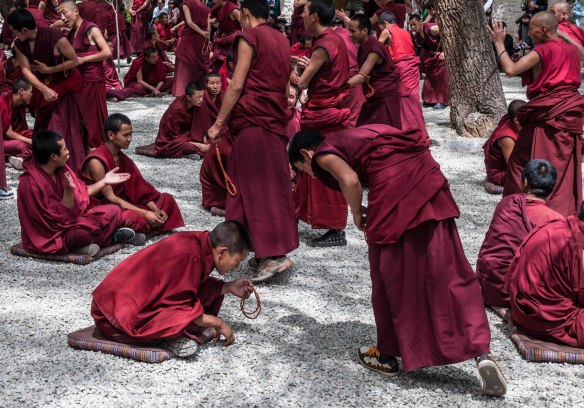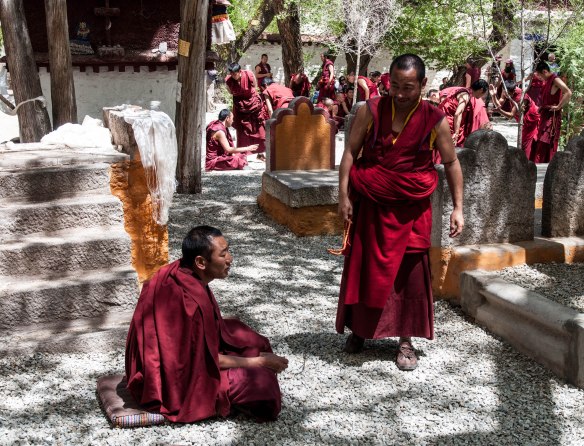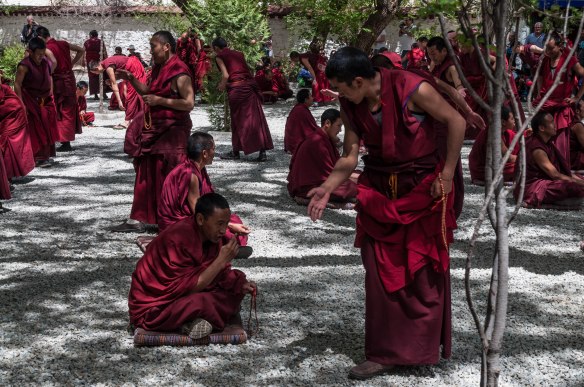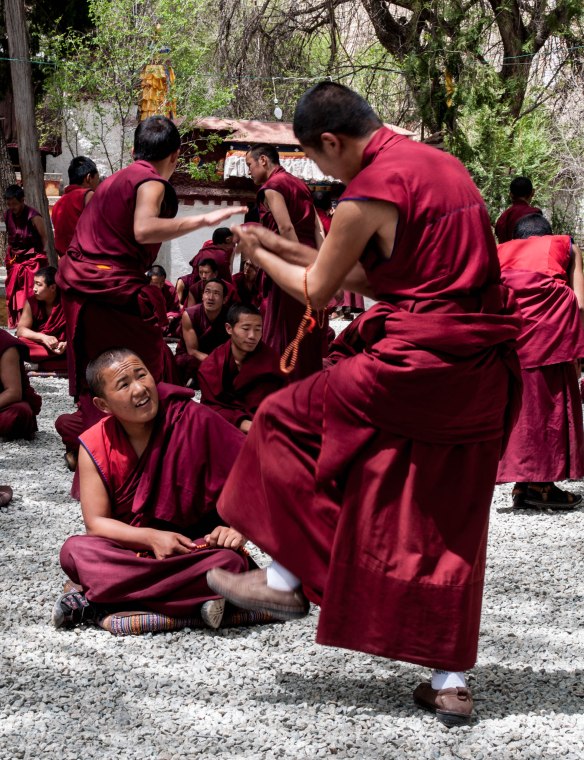The Sera Monastery is one of the three most important monasteries in Lhasa, the Holy City of Tibetan Buddhism. The others are the Drepung and Ganden Monasteries. They are dedicated to the Gelugpa or Yellow Hat Sect of Tibetan Buddhism and are, or at least were, university monasteries. In earlier times life in Tibet revolved around the monastery. The monasteries played the role of religious center, education center with schools and universities, hospitals, marketplaces, and so on. Even now, much of a young person’s education can still be had at a monastery. The Sera Monastery was built in 1419 on a hillside in the north part of Lhasa.
One of the unique things about Sera is it’s long tradition of debating. As part of the their training, monks participate in a series of debates. These debates are held in a courtyard of crushed stone. Senior monks grill junior monks on various doctrine. The junior monks are seated, while the monks questioning their knowledge of Buddhist scripture fire questions at them, accompanied by dramatic hand slapping. The hand slapping is a signal for the seated monk to respond.
 The debates are held each day. Though it seems pretty entertaining to the visitor, it is serious business and an important part of the training of these monks. Tibetan Buddhist monks are never without their prayer beads. In fact, most lay people in Tibet also carry prayer beads.
The debates are held each day. Though it seems pretty entertaining to the visitor, it is serious business and an important part of the training of these monks. Tibetan Buddhist monks are never without their prayer beads. In fact, most lay people in Tibet also carry prayer beads.
The debates last one to one and a half hours. It was noisy and the air was charged with energy.
The short video below best shows how these debates are conducted. I found this religious training fascinating. I have always loved Buddhist temples and monasteries for the peace and tranquility that I feel there. This was a little different because it was so noisy and lively.





Pingback: Contents May Have Shifted by Pam Houston | Impressions Travelogue
Pingback: GE2111 Image of the City: How Religion Builds the Image of Lhasa
The video was so interesting to watch, and I loved the photos. It’s strange to think of monks debating, but it seems a vital and important part of their day and training for junior monks. It makes you realize just how much scripture they must know.
This long tradition of debating seems to me as a learning experience and was to gain knowledge of the various doctrines used by Tibetan Monks. A very interesting way to learn, but truly shows if one knows the material by putting them on the spot with random questions, in front of tourists and elder monks. I’m curious, is this part of the process to become a Senior Monk or just a way to learn the doctrines?
This concept is very interesting to me because, as you note at the end of your post, I have always known monasteries to be very peaceful and quiet places and this ritual shows an energy that is exactly the opposite. I think this illustrates how important it is to be respectful of all cultures and traditions whether we, as visitors, understand them or not, because, again as you noted, a tradition such as this may be quite entertaining to visitors.
Monks tend to have the stereotype that they are very quiet and peaceful. This post shows the complete opposite! It is quite interesting to see that debating is a tradition, rather than a problem that people are trying to solve. I am curious to why having debates is part of a monks training. I find it interesting how these debates are so serious to this religious community, but they come off as entertainment to the average viewer walking by.
I don’t think that the stereotype of a monk being peaceful necessarily lies in contrast with vigorous debate. It is because of the challenge to any accepted status quo, that growth and understanding might be cultivated. Violence often is a result of unbending, and often ignorant, stances on rigid positions. This type of discourse is healthy and productive, and also a facet of peacefulness and the search for truth. There is a very good book called Humble Before the Void written by University of Arizona professor Christopher Impey where he brings notions of western science to Tibetan monks and all of their assumptions are collectively challenged in a positive way as a result of this type of interaction.
This was a very interesting practice to see in action. I had always assumed monks spent most of the day praying and seeking enlightenment in the quiet humble atmosphere of the monastery. It is a unique experience to be able to see this piece of the Tibetan Monk traditions. It is beautiful to see the monastery still a large part of Tibetan life and maintained for centuries by these monks and others throughout Tibet.